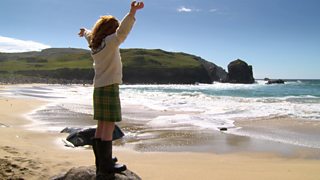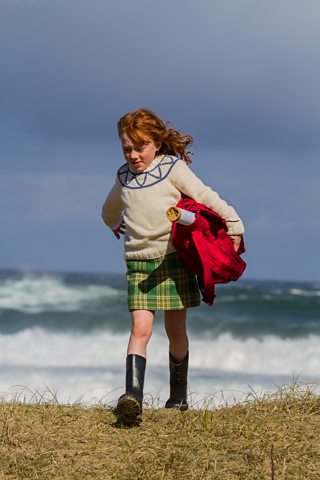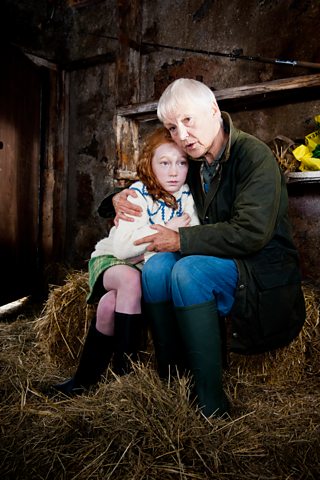Editor's Note: All this week following we're looking at programmes being produced in Scotland and which offer opportunities for writers across all genres. We begin with Children's programmes, as the Producer of the show Katie Morag explains the writing process, and how they manage to tackle serious issues like grief for a pre-school audience.

Katie Morag (Cherry Campbell)
What an honour it was to have the opportunity to adapt for the .
But what responsibility! Truthfully? It was petrifying.
Generations of readers had cherished each syllable and every tiny detail of her illustrations for over thirty years. We had to make the programmes authentic to the books - funny, touching, beautiful and wise, and make them resonate, for Mairi, for the Βι¶ΉΤΌΕΔ and for Katie Morag fans everywhere.
is based in Cromarty, North East of Inverness. From the outset we were determined to keep as much of the production in the Highlands as we could, beginning with the writing.
We gathered our team up here for the writing sessions: writers , and , trainee writers, and Lou Wylie, script editor, (now Βι¶ΉΤΌΕΔ Writersroom's Development Producer for Scotland), two producers and me, and the director, . Βι¶ΉΤΌΕΔ Execs and came along when they could. And we invited too, because we wanted her to feel involved in the team right from the start.
At first she declined.
“Lindy I’ve handed Katie Morag over to you, she’s your responsibility now.”
(Right. No biggie!)
But in the end she agreed to come along “just for a short while to say hello”.
By the end of the sessions Mairi was just as much part of the team as any of us, firing in suggestions, laughing away any particularly outrageous flights of fantasy, and even writing a script of her own!
And I wouldn’t have liked it any other way.
The stories were her provenance - the books were based on her own experiences raising her family on . Some of the characters are based on real people. We had a ginormous duty of care.

We had a great time. What could be more fun than sitting in a room full of bright, funny, creative people, scones a-plenty, reading Katie Morag stories to each other and then working out how we could adapt them?
Some of the existing stories would prove impossible for us to adapt; some of the scenarios were totally impractical, which is why it was really excellent to have the director and producers there, for their practical reigning-in of the blue-sky thinking!
We had long discussions about how to portray a totally free-range child, who had the run of the island and was often alone, in a way that would not inspire a legion of small viewers to emulate her. In the end I think we found a balance, compromising on some of the freedoms, but guarding others.
I had written a 'Bible', which included character breakdowns, Struay traditions and Island events, iconic sayings and random quirks, all taken from the books; plus some idea of the format. All the films were to be roughly 12 minutes long, plus titles and the end scene. The end scene was always to be in the bedroom, because Mairi’s books always tend to have a night time picture on the last page. We would then be able to have Katie Morag reflecting on the theme of the episode in voice-over. Voice-over was important, it would enable us to move the story along, and was helpful because of the little amount of filming time we would have with our child lead. (Regulations allow a child of that age to be on set for 3 hours per day maximum, and our schedule allowed only 2.5 shoot-days per episode on Series One).
Katie Morag would then end each episode by shining her torch out of the window and across the bay to say goodnight to Grannie Island and we’d then always cut to a wide shot (animated) of the bay at night, per the books, thereby giving some continuity and familiarity to each episode, something which is so important to little viewers.

Katie Morag (Cherry Campbell) Liam (Peter and Finlay MacMillan) and Grannie Island (Ann Louise Ross) outside the Post Office
In the end we brought eight of Mairi’s original tales to life in Series One. But we had a commission for 26 episodes, so we also had to write more Katie Morag stories for both of the series. Which was equally fun! We brainstormed potential themes, stories and issues. We made a timeline for events - again it was great to have Mairi there, in the books she could move time along and introduce people and things without explanation, but for a weekly TV show, we had to have a chronology.
Katie Morag’s mother has a baby in the Tiresome Ted book, so where in the series would we place that episode? Could any other stories emerge from the prospect of a new sibling? One book, , features a New Teacher. We discussed what might have happened to the old teacher, who is never mentioned in Mairi’s books. Perhaps she retires and her leaving could coincide with the baby’s impending arrival? Perhaps all this change might be too much for the wee girl to cope with? was duly written around that theme.
At the end of each of the writing sessions we allocated the stories to different writers. They took our basic Beat Sheets - a summary of the storyline, and they put the flesh on the bare bones to bring them alive. Once we had reached final drafts stage, Sergio Casci, our lead writer, wrote the voice-overs. It was important that Katie Morag’s voice had the same tone in every episode for the series to cohere.

The Presentation of the Sheep Contest Cup at the Struay Show
During the discussions we talked about doing an episode that explored the theme of death, even in a small way. Our series already portrayed all kinds of emotional, sometimes uncomfortable feelings, and we didn’t want to leave out grief. But we couldn’t have one of our human characters die; it would be far too traumatic for our young viewers. We felt we couldn’t even have a beloved animal die for the same reason. But we could perhaps allude to the inevitability of one dying, thereby creating a natural setting for the big questions that might emanate from any child. It’s difficult to find words of comfort - especially for those of us who have no religious faith. But the more we talk about death and dying the more healthily we can expect our children to cope with it when, in due course (but hopefully not for a very long time) they encounter it.
My own father died when I was barely 17. But it seems I must nevertheless have given my own children a vivid picture of him through telling his stories and using his nonsense phrases in my everyday parlance , trying to find him again for myself I guess. One day, my then 15 year-old daughter said that every time she read about during To Kill a Mockingbird studies, she pictured my Dad because Finch had traits that reminded her of him. And it struck me as remarkable, that a man who had died 17 years before she was born could be so alive and vivid in her imagination.

Katie Morag and Grannie Island in Katie Morag and the Sick Sheep
So at our writing session we discussed this, and we assembled the bones of a gentle (and I hope reassuring) story which went on to be exquisitely realised by Sergio Casci, to be beautifully filmed by director Don Coutts and our crew, and to be movingly acted by Cherry Campbell (Katie Morag), Kenny Harvey (Mr. McColl) and Ann Louise Ross (Grannie Island): .
None of us truly knows what will happen after we die, many of us feel inadequate when trying to be clear or reassuring to the children who cry in their sleep. But one thing is true - as long as there is someone still alive who talks about us, or tells our stories, or polishes a little white stone on a cairn for us, then a little part of us is left behind, living on.
in our script library
